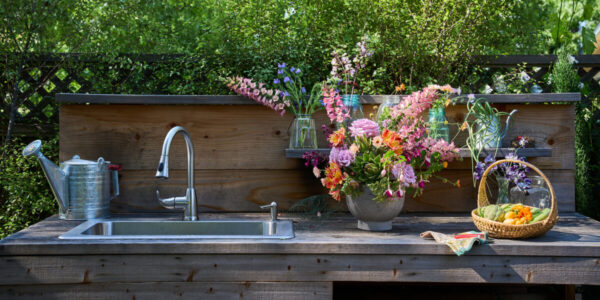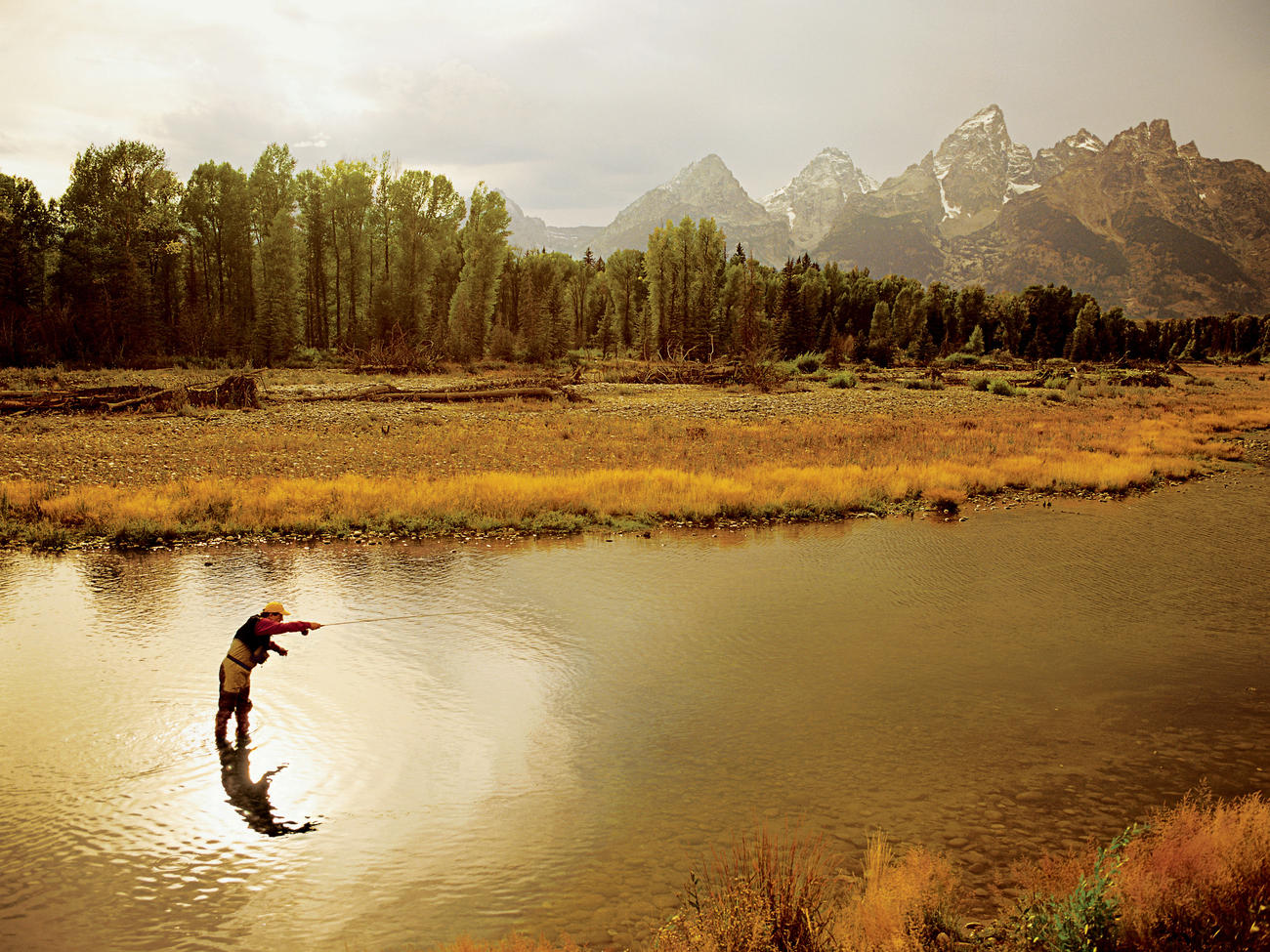
Discover Jackson Hole

Travel planner: What to do, where to stay, and where to eat in Jackson Hole
With all due respect to heaven, it’s got nothing on Jackson Hole at dawn. A.J. DeRosa is heading out on a float trip down the Snake River. A native of Chicago, DeRosa arrived in this corner of Wyoming in 1972. He’s been guiding on the river for 27 years using wooden boats handmade from Douglas fir.
The river is running high, and the boats settle into the current south of the Wilson Bridge. The head of a bald eagle flashes white as it catches sunlight high in the trees. In stretches, DeRosa stops paddling and the boat wheels in lazy circles, creating a kaleidoscopic panorama of Jackson Hole: blue sky, cottonwood forest, and the dark, jagged summits of the Tetons.
A few riffles aspire to whitewater, but the Snake remains quiet enough that it’s easy to hear the castanet-like crackles of stream-smoothed cobbles as the current pushes them along the river bottom. “When I was 8,” DeRosa says, “I used to lie in my uncle’s boat in Wisconsin so I could listen to the water lapping up against the wooden hull. I still get to hear that sound. Every day.”
Life in the valley known as Jackson Hole is filled with such connections to what may be the most spectacular of all American landscapes. “Sense of place” isn’t a genteel catchphrase in this 60- by 20-mile area but an in-the-gut feeling. Residents of Jackson proper often recall a moment when they knew that they were going to live here. For many it was seeing the Tetons rising over the valley floor like mountains out of childhood imaginings. Jobs? Housing? All of that will work itself out. One way or another. Because sometimes you just know where you have to be.
Head out of the airport and you immediately sense you’re in a different kind of place. Grand Teton National Park surrounds the airport, and minutes out of baggage claim, you’re likely to spot such wildlife as moose, bison, and elk; in fall and winter, the valley is home to North America’s largest elk herd.
“It’s hard to move to Jackson and just take up where you left off,” says Nancy Shea, the former executive director of the Murie Center, Jackson’s nationally known wilderness advocacy group. “You’re living in a very different kind of place. Here it’s personal: You have a moose in your backyard.”
Shea tells a story about one resident who lives along the Snake. The man loved his yard’s landscaping―as did the local moose. “He decided to share,” Shea says. “His perspective was, ‘They get a little and I get a little. If I’m going to live here, I won’t be a perfectionist.'”
Next: Pretty close to perfection
That said, for anyone oriented toward the outdoors, Jackson Hole comes pretty close to perfection. Ninety-seven percent of the valley is state and federal land, while the Jackson Hole Land Trust has gained protection for another 15,000 acres of ranchland through conservation easements. And so Jackson has some of the country’s best out-your-front-door recreation.
In winter, people working downtown can get in runs during their lunch hour at the Snow King ski area. In warmer months, there’s prime trout fishing, climbing, or mountain biking. All year, there’s proximity to Grand Teton National Park.
“I feel like the park is my backyard,” says Laurie Andrews, executive director of the land trust. “I think everyone does.”
High up in Teton Pass, a sign depicts a bucking bronco and declares, “HOWDY STRANGER. YONDER IS JACKSON HOLE―THE LAST OF THE OLD WEST.” The reality, however, is that Jackson Hole is the epitome of the New West.
From 1997 to 2003, Teton County ranked as the nation’s wealthiest county four times; the other three years, it came in second. Tourism is the biggest employer, but the area’s affluence is apparent in the fact that the largest source of income among its residents is from investments, not salaries.
Jackson’s growth can largely be attributed to economic and technological changes that have allowed entrepreneurs who are well into their careers to move here and run their businesses remotely. Jonathan Schechter―executive director of the Charture Institute, a Jackson-based think tank that studies resort and national-park gateway communities―says, “People have a great ‘ah-ha’ moment when they realize that instead of a two-week vacation, it’s possible for them to live full-time in the place that they love more than anywhere else in the world.”
Even so, many longtime residents hold on to a perception that prices have been driven up by part-timers who maintain second or even third homes in Jackson Hole. Typically these outlanders are lampooned for their conspicuous consumption and lack of community commitment. One local derided them as “Nantucket cowboys,” while another resident referred to them as 228ers: two people for two weeks a year in 8,000 square feet.
Unlike the newer compounds out in the valley, houses in town reflect more humble times. Parcels are small and homes are simple, although older structures are giving way to new ones, many in updated versions of Jackson’s traditional log cabin style.
Driving through the East Jackson neighborhood, architect Eric Logan acknowledges the pull toward Jackson’s rugged past and the noticeable influence of such national-park icons as Yellowstone’s Old Faithful Lodge.
Logan, a Wyoming native and an associate with Carney Architects, has lived here since 1995. He believes that Jackson’s architecture can tap into tradition while reflecting its modern realities. “The Yellowstone lodge is phenomenal,” says Logan, “but we don’t need another one.”
Faced with the area’s real estate costs, Logan says he “bit the bullet and bought some dirt” and decided to design his own house, keeping costs down by serving as general contractor. He sought variances from his homeowners association to incorporate oxidized steel and other nontraditional materials. Some bruising battles he won; others he lost.
Jonathan Schechter believes that such conflicts arise when people’s personal visions of Jackson collide. “People come to Jackson and fall in love with what it was at that specific time,” he says. “Then someone else comes in with another vision that threatens to destroy the fantasy. The problem is that my idealized Jackson may be very different from your idealized Jackson. And you don’t want to mess with someone else’s thunderbolt.”
Even as millionaire entrepreneurs run their businesses via Wi-Fi from the banks of the Snake, a morning radio show called “Trash and Treasures” serves as a hi-fi bulletin board for people looking for rides to Denver or who want to sell an old sofa. There are both gated estates and picket fences made of old skis here, and while there is no storefront Starbucks, you will find the Jackson Hole Roasters, a coffee spot located in a 1920s-vintage cabin cluttered with sacks of beans and roasting equipment. Change has come to Jackson, but the soul of the valley survives.
Next: Living in Jackson Hole
It’s a warm summer night and the county fair is in town. The fair’s climactic event, the demolition derby, is drawing big crowds to the fairgrounds. Crowded too is the upscale Old Yellowstone Garage, which hosts a pizza night on Sundays, when servers circulate with an ever-changing array of creations fresh out of wood-fired ovens. Shaking his head with a broad, disbelieving smile, the restaurant’s owner, David Gilbert, comes wheeling past a table and declares, “This is just too crazy,” before quickly disappearing again.
Across the Snake River in Wilson, the parking lot at the Stagecoach Bar is packed. There are Ford pickups with gun racks and Subarus with Thule bike racks. Inside, river guides in Tevas and Patagonia mingle with cowboys in Justins and Wranglers, all here to watch the house band run through Hank Williams and countrified Beatles.
The band rips into a gloriously ragged version of “Hey, Good Lookin'” before one member declares, “That was fun. That was so much fun we gotta take a break.” You don’t want to place the burden of metaphor on a joint that’s really all about simple good times. But the bar is not unlike Jackson Hole. The things that bring people here are still bigger than the things that might otherwise keep them apart.
VITAL STATS
Population: 18,251 in Teton County
Growth: 63% between 1990 and 2000
Elevation: About 6,300 ft.
Average August High/Low: 80°/38°
Average January High/Low: 27°/5°
Median home price: $615,000
Median age: 35
FYI: Although it’s the voting residence of Vice President Dick Cheney, Teton County was Wyoming’s only county where John Kerry defeated President Bush (53% to 45% )Moving to Jackson?
You don’t have to be Harrison Ford to live in Jackson Hole, but it doesn’t hurt. Jonathan Schechter, executive director of the Charture Institute, offers a few points to consider.
Start with a thunderbolt. If there isn’t something about this place that touches your soul, you’re probably wasting your time. Jackson Hole is wonderful, but it’s also remote, with long winters. You really have to want to be here.
Have a portable income. It helps if your job or business can be done from any location.
Have a financial cushion. If you hope to start a business, you’ll need time to figure out your strategy after you arrive. Jackson has its opportunities, but fewer than in larger cities.
Manage expectations. Do you want a home on 5 acres with a stream? Or are you willing to consider a smaller property to live in Jackson Hole proper and enjoy a Teton view? Avoid disillusionment by understanding your goals.See Jackson Hole
